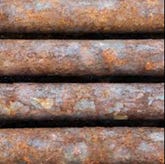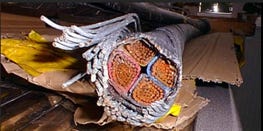Enhancing Durability and Efficiency: The Role of Corrosion-Resistant Alloys in Heat Tracing Systems
Exploring the Role of Advanced Materials in Combating Corrosion Challenges
Abstract:
Corrosion-resistant alloys (CRAs) play a pivotal role in the design and performance of heat tracing systems, particularly in demanding industrial environments. By offering superior durability and protection against harsh conditions, CRAs ensure the longevity and efficiency of heating cables. This article delves into the importance of corrosion-resistant alloys, their properties, and their application in heat tracing systems.
Electric heat tracing systems are used in industrial environments to maintain or raise the temperature of pipes, vessels, and other equipment. However, in harsh conditions, these systems are prone to corrosion if constructed from unsuitable materials.
Corrosion Challenges in Industrial Systems
Understanding the Industrial Corrosion Problem
Industrial plants, including chemical processing facilities, refineries, and offshore platforms, are exposed to extreme environmental conditions that accelerate corrosion. Corrosion occurs due to chemical reactions between metals and their surroundings, compromising system integrity, safety, and efficiency.
Types of Corrosion in Industrial Plants
Corrosion in Industrial Systems occurs due to various mechanisms, depending on the environment:
Uniform Corrosion: A slow and steady loss of material occurs uniformly across the cable's surface due to exposure to moisture or mild chemicals.
Pitting Corrosion: Localized damage caused by chloride ions, especially in environments like offshore platforms or chemical plants. Pitting can penetrate deep into the material, weakening its structure
Crevice Corrosion: Occurs in shielded areas such as under insulation or at joints, where stagnant moisture and corrosive agents concentrate.
Stress Corrosion Cracking (SCC): A combination of tensile stress and a corrosive environment causes cracks to form, particularly in alloys exposed to high temperatures and chloride-rich conditions
Oxidation: At high temperatures, metals react with oxygen to form oxides, which reduce the material's thermal and mechanical properties.
Galvanic Corrosion: Occurs when two dissimilar metals are electrically connected in the presence of an electrolyte (e.g., water). The less noble metal corrodes preferentially.
The Impact of Corrosion on Electric Heat Tracing Systems
Electric heat tracing systems maintain or raise the temperature of pipes, vessels, and equipment in industrial environments. However, if not constructed from corrosion-resistant materials, they are vulnerable to damage.
What Happens Without Corrosion Resistance?
Non-corrosion-resistant heat tracing systems are vulnerable to environmental factors like moisture, chemicals, and temperature fluctuations. Over time, this leads to:
Material Degradation: The metal in heating cables corrodes, weakening the structure.
Reduced Efficiency: Corrosion affects thermal conductivity, reducing heat transfer efficiency.
System Failures: Advanced corrosion can cause electrical short circuits, breakages, or complete system failure.
When heating elements corrode, several critical issues arise:
Thermal Conductivity Loss: Corroded heating elements develop layers of oxides and other compounds on their surface. These layers act as insulators, reducing the ability of the heating element to transfer heat effectively. This inefficiency leads to uneven heating or insufficient temperature maintenance.
Structural Weakness: Corrosion eats away at the metal, leading to thinning and weakening of the heating element. Over time, this structural degradation can cause breakages, exposing electrical components and creating safety hazards.
Electrical Failures: Corrosion can compromise the insulation of heating cables. When moisture or corrosive agents penetrate the insulation, it leads to short circuits and potential fire risks.
Increased Downtime and Maintenance: Systems with corroded components require frequent repairs or replacements, leading to operational disruptions and higher maintenance costs.
For instance, in a marine environment, chloride ions from saltwater accelerate the corrosion process, leading to pitting and structural damage. In chemical processing plants, exposure to acids or alkalis can result in rapid material degradation. The lack of corrosion resistance compromises both safety and performance, leading to frequent replacements and increased operational costs.
The Solution: Mineral-Insulated (MI) Cables with Corrosion-Resistant Materials
To combat corrosion challenges in heat tracing systems, the use of mineral-insulated (MI) cables with corrosion-resistant alloys has become essential. These cables are designed to withstand harsh industrial conditions, providing durability and efficiency.
What Are Corrosion-Resistant Alloys?
Corrosion-resistant alloys (CRAs) are specialized metallic materials engineered to withstand degradation caused by environmental factors such as oxidation, moisture, and chemical exposure. Their unique chemistry includes elements that impart exceptional resistance to corrosive processes, making them essential in environments where standard materials would fail.
The key to the effectiveness of CRAs lies in their chemical composition:
Chromium (Cr): A vital component, chromium forms a thin, stable oxide layer (chromium oxide) on the surface of the alloy. This passive layer acts as a barrier, preventing further oxidation and corrosion.
Nickel (Ni): Enhances the alloy’s resistance to chemical attack, especially in acidic environments, and improves ductility and toughness.
Molybdenum (Mo): Provides resistance to pitting and crevice corrosion, particularly in chloride-rich environments.
Titanium (Ti) and Niobium (Nb): Stabilize the alloy structure, reducing the risk of intergranular corrosion.
Iron (Fe): Forms the base metal in many CRAs, providing strength and durability.
CRAs are indispensable in industrial applications where harsh conditions prevail. Their importance stems from the following factors:
Resistance to Degradation: In aggressive environments, such as those containing salts, acids, or high humidity, standard materials corrode rapidly. CRAs maintain their integrity, ensuring reliable operation.
Longevity and Cost Efficiency: The use of CRAs reduces the frequency of replacements and maintenance, leading to significant cost savings over the lifespan of equipment.
Safety: Corroded materials can lead to catastrophic failures in critical systems, posing risks to personnel and operations. CRAs mitigate such hazards.
Efficiency in Heat Tracing Systems: Corrosion negatively impacts the thermal conductivity and structural integrity of materials. CRAs ensure consistent heat transfer and system performance.
Types of Corrosion-Resistant Alloys Used in MI Heating Cables
The electric heat tracing industry relies on a variety of corrosion-resistant alloys to ensure the durability and efficiency of heating cables. Each alloy is chosen based on its unique properties and the specific environmental conditions it can withstand. Here are the most used alloys and why they are preferred:
Stainless Steel Alloys (304, 316, and 321)
Properties:
Stainless steel alloys, especially 316, have high chromium (18-20%) and nickel (8-12%) content, with molybdenum (2-3%) added to enhance resistance against chloride-induced pitting and crevice corrosion.Applications in Heat Tracing:
These alloys are effective in environments with moderate exposure to moisture, mild chemicals, and salts, such as food processing plants and water treatment facilities.Corrosion Resistance Factor: Stainless steel braided layers protect against uniform corrosion and chloride pitting. The molybdenum content in the alloy ensures resistance to localized corrosion in moderately salty or wet environments.
Corrosive Conditions: Used in environments prone to condensation, wet pipe insulation, or minor salt contamination, such as water processing pipelines. The stainless-steel braid ensures mechanical durability while preventing material degradation.
Inconel Alloys (Inconel 600, 625)
Properties:
Composed mainly of nickel with chromium and iron, Inconel alloys offer excellent resistance to oxidation, high-temperature corrosion, and chloride-induced stress corrosion cracking (SCC).Applications in Heat Tracing:
Inconel alloys are preferred for high-temperature environments, such as oil refineries, chemical processing plants, and offshore platforms exposed to aggressive chemicals.Corrosion Resistance Factor: Inconel’s high nickel content resists chloride SCC and oxidation at elevated temperatures (up to 1000°C).
Corrosive Conditions: Used in conditions where hot piping systems face exposure to chloride-rich atmospheres or sulfur-based chemicals, such as in oil and gas refineries. Inconel components ensure sustained performance despite aggressive chemical vapors and high thermal stress.
Monel Alloys (Monel 400, 500)
Properties:
Monel is a nickel-copper alloy with excellent resistance to seawater, hydrofluoric acid, and sulfuric acid. Its high ductility ensures resistance to stress corrosion cracking under mechanical stress.Applications in Heat Tracing:
Ideal for marine applications, offshore platforms, and storage tanks exposed to acidic or saline environments.Corrosion Resistance Factor: Monel’s unique combination of nickel and copper ensures superior resistance to seawater corrosion and acidic environments.
Corrosive Conditions: Applied in offshore platforms with high exposure to saline spray, moisture ingress, and acidic by-products from petrochemical processes. The alloy’s stress corrosion cracking resistance ensures durability under fluctuating mechanical loads.
Hastelloy Alloys (C-22, C-276)
Properties:
Hastelloy alloys, with high molybdenum and chromium content, exhibit superior resistance to pitting, crevice corrosion, and oxidation. They maintain structural integrity under high stress and extreme temperatures.Applications in Heat Tracing:
Commonly used in chemical processing facilities handling aggressive agents like hydrochloric acid and sulfuric acid.Corrosion Resistance Factor: Hastelloy’s molybdenum provides exceptional pitting resistance, while chromium ensures protection against oxidizing agents.
Corrosive Conditions: Suitable for environments where heating systems encounter concentrated acidic vapors, such as chemical reactors or acid storage pipelines. The alloy prevents crevice corrosion under insulation or joints, ensuring operational reliability.
Titanium Alloys
Properties:
Titanium is known for its outstanding resistance to chloride-induced corrosion, particularly in seawater, and its lightweight, high-strength nature makes it ideal for specialized applications.Applications in Heat Tracing:
Primarily used in desalination plants, marine structures, and highly corrosive chloride environments.Corrosion Resistance Factor: Titanium components resist chloride ion attack, even in highly saline or brackish water environments.
Corrosive Conditions: Installed in coastal or offshore locations with constant exposure to seawater and salt-laden air. Titanium ensures long-term reliability and resistance to uniform and pitting corrosion, even under extreme saline exposure.
Maximizing Performance: MI Heating Cables for Corrosive Environments
1. Alloy 825 Sheathed Mineral-Insulated (MI) Heating Cable
Why Corrosion Resistant: This cable’s sheath is made from Alloy 825, a nickel-iron-chromium alloy with molybdenum and copper. The molybdenum enhances resistance to pitting and crevice corrosion, while the chromium forms a protective oxide layer that guards against oxidation.
Corrosion Resistance Significance: This cable is exceptionally resistant to chloride-induced stress corrosion cracking and acidic environments, making it suitable for offshore oil rigs and chemical plants.
Example Usage: Successfully deployed in offshore oil platforms to prevent frost and ensure flow assurance in pipelines exposed to chloride-rich seawater. The Alloy 825 sheath provides long-term durability under constant exposure to harsh marine conditions.
2. Inconel 625 Sheathed Mineral-Insulated (MI) Heating Cable
Why Corrosion Resistant: This cable utilizes Inconel 625, a nickel-based alloy with high chromium and molybdenum content. The alloy is highly resistant to oxidation, stress corrosion cracking, and pitting in chloride-laden environments.
Corrosion Resistance Significance: It performs exceptionally well in environments with fluctuating temperatures and aggressive chemicals. The high nickel content ensures structural integrity even at elevated temperatures.
Example Usage: Used in chemical processing facilities to maintain the temperature of pipelines carrying aggressive acids, ensuring reliable operation despite exposure to highly corrosive agents.
These examples highlight how the choice of corrosion-resistant alloys directly influences the durability, efficiency, and safety of electric heat tracing systems in challenging industrial environments. The use of advanced materials like Alloy 825 and Inconel 625 ensures these systems can withstand extreme conditions while maintaining consistent performance in offshore oil platforms to prevent frost formation and maintain flow assurance in pipelines exposed to chloride-rich seawater. The Alloy 825 sheath provides long-term durability under these harsh marine conditions, ensuring uninterrupted operation.
Comparison of Corrosion Resistant Alloys used in MI cables
Conclusion
The use of corrosion-resistant alloys in electric heat tracing systems is crucial for their longevity, efficiency, and reliability. By leveraging advanced materials like Alloy 825, Inconel 625, and others, manufacturers can ensure that heating cables withstand the harshest environments, from offshore platforms to chemical plants. These alloys not only protect against various forms of corrosion but also optimize the thermal and mechanical performance of heat tracing systems.
The integration of corrosion-resistant alloys extends the lifespan of heating cables, reduces maintenance costs, and ensures operational safety in critical industrial applications. As industries continue to face increasingly demanding environmental conditions, the role of these specialized alloys in heat tracing systems will remain indispensable, ensuring seamless performance and durability in even the harshest environments.













